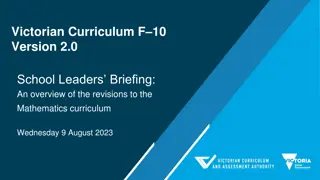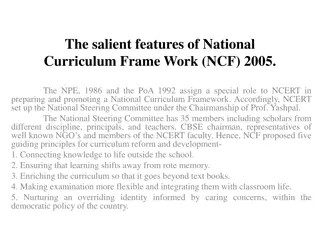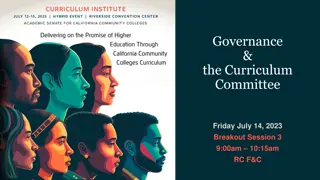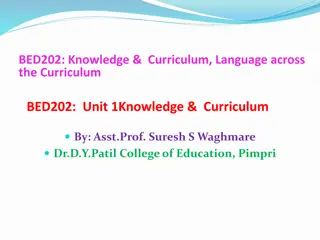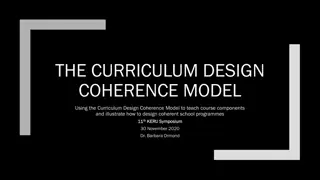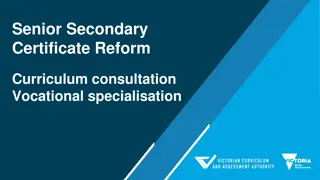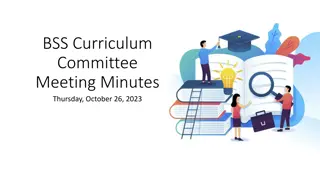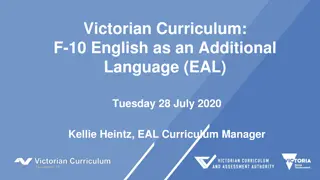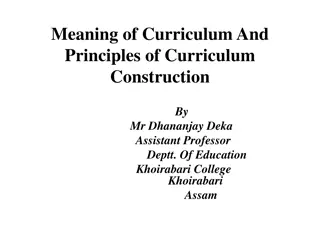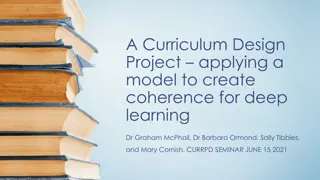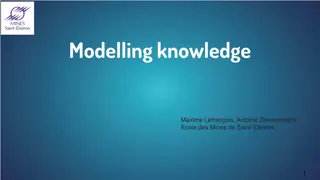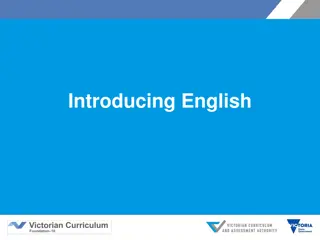Knowledge and Curriculum
The principles of curriculum development to improve education quality, align curriculum with teaching methods, and meet student needs. Discover how innovative curriculum design influences learning outcomes and fosters independent thinking. Curriculum planners play a crucial role in creating effective learning experiences.
Download Presentation

Please find below an Image/Link to download the presentation.
The content on the website is provided AS IS for your information and personal use only. It may not be sold, licensed, or shared on other websites without obtaining consent from the author.If you encounter any issues during the download, it is possible that the publisher has removed the file from their server.
You are allowed to download the files provided on this website for personal or commercial use, subject to the condition that they are used lawfully. All files are the property of their respective owners.
The content on the website is provided AS IS for your information and personal use only. It may not be sold, licensed, or shared on other websites without obtaining consent from the author.
E N D
Presentation Transcript
KNOWLEDGE AND CURRICULUM Unit VII- Principles of Curriculum Development Dr.V.Regina Principal ,Asst,Professor of Biological Science CSI Bishop Newbigin College of Education No.109, Dr.Radhakrishnan salai, Mylapore, Chennai - 600004
Introduction Need for curriculum development Principles of curriculum : 13 Principles Stages of curriculum development Types of curriculum Subject Learner Synopsis Problem Reconstruction design Models of curriculum development Tyler's curriculum inquiry model Taba grassroots rationale model Conclusion Dr. V. Regina , Principal CSI BISHOP NEWBIGIN COLLEGE OF EDUCATION
To improve education quality special efforts are needed to align the intended curriculum. Learning Objectives To improve the quality and relevance of the curriculum To improve the quality and linkage to teaching , learning and assessment process (IBE-UNESCO) Emphasized the usage methods of curriculum and assessment. Implements the quality to the students need. Learning Outcomes Characterizes the principles of the curriculum. Dr. V. Regina , Principal CSI BISHOP NEWBIGIN COLLEGE OF EDUCATION
Introduction Innovative and demand-driven curriculum enables a Curriculum development is defined as the process college or university to remain relevant and to be one step of Selecting, organizing, executing and evaluating ahead of its rivals, set trends and lead change in order to the learning experience on the basis pf the needs, survive. abilities and interest of learners and on the basis of the nature of the society and community. Curriculum development is planning development for Curriculum development or transformation is one schools, It involves the techniques and methods for of the critical challenges of any successful developing, designing, implementing, evaluating and institution of higher education. improving the curriculum . Curriculum development is a continuous process- purposeful activity. Dr. V. Regina , Principal CSI BISHOP NEWBIGIN COLLEGE OF EDUCATION
Education goals are changing Needs of both students and the society Globalization helps in continuous and comprehensive education Innovation is educational technology Democracy in education Knowledge economy demands Need for Curriculum Development Curriculum planners and also plan for facilitating learning for students. To create independent thinking and self-reliance Evaluation and purposeful activity Helps in the selection of learning experience It helps in the selection of study matter Needed for appropriate selection and organization of learning experiences. Dr. V. Regina , Principal CSI BISHOP NEWBIGIN COLLEGE OF EDUCATION Dr. V. Regina , Principal CSI BISHOP NEWBIGIN COLLEGE OF EDUCATION
Principles of Curriculum 6. Principle of Creativity:- should be made for creative type 1. Principle of Child Centredness:- Age, interest, activities capability, capacity, aspiration, needs and psychology of the learner should be taken as consideration. 7.Principle of Preservation:- preservation and transmission of the knowledge, tradition, standards of conduct. 1. Principle Of community-centeredness:- the social needs and local needs of the learners should be taken into account 8.Principle of variety : Variety of knowledge, the varying interests while we construct the curriculum. and needs. 1. Principle of balance/integration:- related to the social 9.Principle of Flexibility: Enough time and sufficient chance to the environment of the students - integrated with cognitive , students. affective and psychomotor objectives. 10.Principle of contemporary knowledge: Modern or current 1. Principle of need:- fulfilling the needs of the learner. knowledge to the students. 1. Principle of utility:- curriculum should provide rich experiences both academic and social to the students. Dr. V. Regina , Principal CSI BISHOP NEWBIGIN COLLEGE OF EDUCATION
Principles of Curriculum 11.Principle of Sequencing:- content and skills are ordered and 17.Principle of Totality of Experiences :- manifold curricular, co- presented to learner overtime. curricular and extra curricular activities. 12.Principle of continuity/correlation :- develops worthy interest 18.Principle of character formation : affective education for this and attitude in students. character training.. 13.Principle of accuracy:- several textbooks and knowledge 19.Principle of Mental Discipline: Cognitive training and practice to requires some degree of spread and accuracy train.. 14.Principle of Interest:- curriculum should be designed to sit the 20.Principle of social fulfilment: social context of the children. interests and tastes of the age group of students.. 21.Principle of Training for leisure : co-curricular, extra curricular, 15.Principle of Readiness:- Depending upon the learner s social, athletic sports , games, and dramatics stc readiness to act and bond between stimulus and response. 16.Principle of meaningfulness:- content and knowledge skill requires meaning for the day to day life.. Dr. V. Regina , Principal CSI BISHOP NEWBIGIN COLLEGE OF EDUCATION
Stages of curriculum Development 1.PLANNING 2.CONTENT AND Phases : METHOD I. Development phase 3.IMPLEMENTATION 4.EVALUATION II. Implement phase III. Evaluate phase Steps 1) Identify issue/problem / need 1. Planning 2) Form curriculum development team 2. Developing 3) Conduct needs assessment and analysis 3. Management 4) State intended outcomes 4. Implement 5) Select content 5. Assessment 6) Design experimental method 6. Revision 7) Test and revise curriculum Dr. V. Regina , Principal CSI BISHOP NEWBIGIN COLLEGE OF EDUCATION
Development : Phase II Stakeholders and project leadership approve curricular package developed Planning : Phase I Curriculum development begins with regular feedback. Identify country and project key stakeholders Finalize all curricular materials. Stakeholders and partners decide on clinical priority Implementation : Phase III areas for project and curricular package. Printing production begins Establish a local curricular review working group for iterative curriculum development process. Training and project implementation begins Training participants complete a knowledge assessment. Dr. V. Regina , Principal CSI BISHOP NEWBIGIN COLLEGE OF EDUCATION
Stages of Curriculum Development 1. Planning 2. Content and Method a) Identify Issue /Problem /need: explore some of the a) State intended outcomes: learners are able to do a result of questions that need to be addressed. participating in the curricular activities. b) Form curriculum development Team: the roles of b) Select content: if the intended outcomes is to be attained functions/ process for selecting members and principles of then the development process is selecting content. c) Design, Experiential method: Experience, share, process, collaboration and teamwork formed. c) Conduct needs assessment and analysis: knowledge , generalise and apply should be designed altitude and practice survey. Dr. V. Regina , Principal CSI BISHOP NEWBIGIN COLLEGE OF EDUCATION
Stages of Curriculum Development 3. Implement 4. Evaluation and Reporting: a) Produce curriculum project: suggestions for producing a) Design Evaluation Strategies: two types of evaluation, curriculum materials. formative and summative, are used during curriculum b) Test and revise curriculum: a sample evaluation form in development. b) Reporting and securing Resources: getting the results into provided. c) Recruit and Train Facilitators:suggestions for recruiting the hands of people who can use them. appropriate facilitators are provided with a sample three- day training. d) Implement Curriculum: Strategies to promote and use the curriculum are discussed in this steps. Dr. V. Regina , Principal CSI BISHOP NEWBIGIN COLLEGE OF EDUCATION
Types of curriculum Recommended curriculum: Are typically formulated at a rather high level of generality they are most often presented as policy recommendation,lists of goals, suggested graduation requirements Written curriculum and general recommendation about the content and sequence of a Recommended curriculum field of study , such as mathematics Supported curriculum Written curriculum: The written curriculum is an important Learned curriculum component of authentic literacy- the ability to read , write and Taught curriculum think effectively. Tested curriculum Hidden curriculum Supported Curriculum: Is the curriculum as reflected in and shaped by the resources allocated to support and deliver it. Intentional Curriculum Dr. V. Regina , Principal CSI BISHOP NEWBIGIN COLLEGE OF EDUCATION
Types of curriculum Subject area Curriculum: The subject centered Taught Curriculum: The taught curriculum is the curriculum in which subject is treated as a largely delivered curriculum , where an observer sees in action as autonomous body of knowledge is called subject-area the teacher teaches. curricular. Tested Curriculum: Components of the curriculum Discipline Design: Discipline knowledge is the key determine the fir between what is taught and what is aspect of this curriculum design. Content for the school learned. curriculum is determined in part by identifying or creating a discipline s structure and using this foundation as a guide for selecting the school content and organizing it for Learned Curriculum: The term learned curriculum is learning. used to denote all the changes in values, perception and behaviour that occurs as a result of school experiences. Dr. V. Regina , Principal CSI BISHOP NEWBIGIN COLLEGE OF EDUCATION
Types of curriculum Experience centred Curriculum: This designed closely resembled the child-centred designs in that they used the concerns of children as the basis for organizing the Broad field Design: The knowledge and understanding children's school world. pertinent to whole area of study. Romantic (radical) Design: Teachers are organised not Correlation Design: Correlation is a design employed by to strengthen their own professional security but rather to those who do realize that there are time when separate encourage widespread experimentations in the schools and subjects require some linkage in order to reduce to challenge the outdated structures of society. fragmentation of curricular components. Humanistic Design: The Humanistic model of education stems from the human potential movement in psychology. Child-Centred Curriculum: All school learning A humanistic curriculum emphasis affective rather than activities should be centered on the felt needs and in cognitive outcomes. interests of the child. Dr. V. Regina , Principal CSI BISHOP NEWBIGIN COLLEGE OF EDUCATION
Types of curriculum Problem solving curriculum or society centred Life situation Design: Using such a design based on curriculum : Problem centred design stress the recurring life situation, educators could assist students in importance of the survival of the human and society. It broadening their insights and depending their focuses on the problems of living - on the perceived generalizations about problems relating to the real world. realities of institutional and group life- both for the individual and for the society in general. Dr. V. Regina , Principal CSI BISHOP NEWBIGIN COLLEGE OF EDUCATION
Dynamics of Curriculum 1. Ralph Tyler 1950 mode: This model involves 4 stages Objectives Tyler s curriculum Inquiry Model Content Taba s Grassroots Rationale Model. Method Evaluation Society Philosophy Tentative Objective Precise objective Subject matter Sources Screens Psychology Learner Selecting Experiences Evaluation Dr. V. Regina , Principal CSI BISHOP NEWBIGIN COLLEGE OF EDUCATION
Dynamics of Curriculum 8. Specified the changes to be brought about in the 1. The student as a learner. students to show evidence of objectives. 1. The contemporary life outside the school (society) 9. Determine the contents on subject matter and learning experiences that might lead to the attainment of the stated objectives. 1. Opinion of specialist in the various subjects. 10. It should be relevant, adequate. 1. Consistent, highly important objectives 11. Balanced in term of breadth and depth. 1. Be in line with the educational philosophy goals, aims and objectives. 12. Methods - Principles of continuity, sequence and integration. 1. Psychology of the learner and learning. 13. Evaluation - it involves an appraisal of the students 1. Specified precisely to indicate what is supposed to be actual behaviours. learner, to enable accurate assessment. Dr. V. Regina , Principal CSI BISHOP NEWBIGIN COLLEGE OF EDUCATION
Hilda Taba's Grassroots model Need 1. Diagnosis of needs: The teacher / curriculum design starts the Assessment process by identifying the needs pf the students forwhom the Protocol Amendment Formulative specific objectives curriculum is to be panel. 1. Formulative of objective : after hey teacher has identified needs that required attention, he or she specialis objectives to Selecting content Evaluating be acccomplished. 1. Selection of the content: the objective selected or created suggest to the subject content of the curriculum. Organising content Pilot testing Dr. V. Regina , Principal CSI BISHOP NEWBIGIN COLLEGE OF EDUCATION
Hilda Taba's Grassroots model 6. Organisation of learning activities: just as content 4. Organisation of content : A teacher cannot just select must be sequence and organised .so must the learning activities. content but also match , organize it in same type of sequence taking into consideration the maturity of the learners, their academic achievement and their interests. 7. Evaluation : The curriculum planner must determine 5. Selection of learning Experience: content must be ust what objectives have been accomplished. Evaluation procedures presented to pupils or pupils must engage in an interaction with need to be considered by the students and the teacher. content. Dr. V. Regina , Principal CSI BISHOP NEWBIGIN COLLEGE OF EDUCATION
The curriculum development thus focus on the emerging needs Conclusion of the students in their present lives. This approach prepares the student to face the present rather than the future . on the whole the issues should relate to the developmental stages of the students. Dr. V. Regina , Principal CSI BISHOP NEWBIGIN COLLEGE OF EDUCATION
Suggestive Readings Bobbitt. F. (1918) , The curriculum. Boston: Houghton Mifflin. McDonald, E.S. (2010) A Quick look into the middle school bri. Principal, 89(3), 46-47 Wolk, S, (2010), what should students read? Phi Delta Kappan , 91(7), 8-16. Dr. V. Regina , Principal CSI BISHOP NEWBIGIN COLLEGE OF EDUCATION







